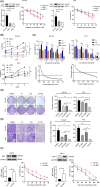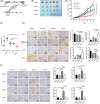MET inhibition enhances PARP inhibitor efficacy in castration-resistant prostate cancer by suppressing the ATM/ATR and PI3K/AKT pathways
- PMID: 34761497
- PMCID: PMC8650038
- DOI: 10.1111/jcmm.17037
MET inhibition enhances PARP inhibitor efficacy in castration-resistant prostate cancer by suppressing the ATM/ATR and PI3K/AKT pathways
Abstract
Up to 30% of patients with metastatic castration-resistant prostate cancer (CRPC) patients carry altered DNA damage response genes, enabling the use of poly adenosine diphosphate-ribose polymerase (PARP) inhibitors in advanced CRPC. The proto-oncogene mesenchymal-epithelial transition (MET) is crucial in the migration, proliferation, and invasion of tumour cells. Aberrant expression of MET and its ligand hepatocyte growth factor is associated with drug resistance in cancer therapy. Here, we found that MET was highly expressed in human CRPC tissues and overexpressed in DU145 and PC3 cells in a drug concentration-dependent manner and is closely related to sensitivity to PARP inhibitors. Combining the PARP inhibitor olaparib with the MET inhibitor crizotinib synergistically inhibited CRPC cell growth both in vivo and in vitro. Further analysis of the underlying molecular mechanism underlying the MET suppression-induced drug sensitivity revealed that olaparib and crizotinib could together downregulate the ATM/ATR signaling pathway, inducing apoptosis by inhibiting the phosphoinositide 3-kinase/protein kinase B (PI3K/AKT) pathway, enhancing the olaparib-induced antitumour effect in DU145 and PC3 cells. In conclusion, we demonstrated that MET inhibition enhances sensitivity of CRPC to PARP inhibitors by suppressing the ATM/ATR and PI3K/AKT pathways and provides a novel, targeted therapy regimen for CRPC.
Keywords: ATM/ATR pathway; CRPC; DNA damage response; MET inhibitor; PARP inhibitor; PI3K/AKT pathway.
© 2021 The Authors. Journal of Cellular and Molecular Medicine published by Foundation for Cellular and Molecular Medicine and John Wiley & Sons Ltd.
Conflict of interest statement
The authors declare no conflict of interest.
Figures





Similar articles
-
Synergistic anticancer efficacy of MEK inhibition and dual PI3K/mTOR inhibition in castration-resistant prostate cancer.Prostate. 2015 Nov;75(15):1747-59. doi: 10.1002/pros.23057. Epub 2015 Aug 7. Prostate. 2015. PMID: 26250606
-
A Crosstalk Between Castration-Resistant Prostate Cancer Cells, M2 Macrophages, and NK Cells: Role of the ATM-PI3K/AKT-PD-L1 Pathway.Immunol Invest. 2023 Nov;52(8):941-965. doi: 10.1080/08820139.2023.2258930. Epub 2023 Nov 24. Immunol Invest. 2023. PMID: 37732622
-
Androgen receptor inhibitor-induced "BRCAness" and PARP inhibition are synthetically lethal for castration-resistant prostate cancer.Sci Signal. 2017 May 23;10(480):eaam7479. doi: 10.1126/scisignal.aam7479. Sci Signal. 2017. PMID: 28536297 Free PMC article.
-
PI3K-AKT-mTOR signaling in prostate cancer progression and androgen deprivation therapy resistance.Asian J Androl. 2014 May-Jun;16(3):378-86. doi: 10.4103/1008-682X.122876. Asian J Androl. 2014. PMID: 24759575 Free PMC article. Review.
-
A Novel Use of Olaparib for the Treatment of Metastatic Castration-Recurrent Prostate Cancer.Pharmacotherapy. 2017 Nov;37(11):1406-1414. doi: 10.1002/phar.2027. Pharmacotherapy. 2017. PMID: 28895177 Review.
Cited by
-
NAD+-A Hub of Energy Metabolism in Heart Failure.Int J Med Sci. 2024 Jan 1;21(2):369-375. doi: 10.7150/ijms.89370. eCollection 2024. Int J Med Sci. 2024. PMID: 38169534 Free PMC article. Review.
-
Traject3d allows label-free identification of distinct co-occurring phenotypes within 3D culture by live imaging.Nat Commun. 2022 Sep 9;13(1):5317. doi: 10.1038/s41467-022-32958-x. Nat Commun. 2022. PMID: 36085324 Free PMC article.
-
RAD18 promotes cell malignant behaviors of esophageal squamous cell carcinoma by modulating ATM/STAT3/PD-L1.Chromosoma. 2025 Jul 9;134(1):6. doi: 10.1007/s00412-025-00832-6. Chromosoma. 2025. PMID: 40632228
-
Androgen Receptor Splice Variants Contribute to the Upregulation of DNA Repair in Prostate Cancer.Cancers (Basel). 2022 Sep 13;14(18):4441. doi: 10.3390/cancers14184441. Cancers (Basel). 2022. PMID: 36139600 Free PMC article.
-
Effect of ubiquitin protease system on DNA damage response in prostate cancer (Review).Exp Ther Med. 2023 Nov 24;27(1):33. doi: 10.3892/etm.2023.12321. eCollection 2024 Jan. Exp Ther Med. 2023. PMID: 38125344 Free PMC article. Review.
References
Publication types
MeSH terms
Substances
LinkOut - more resources
Full Text Sources
Research Materials
Miscellaneous

